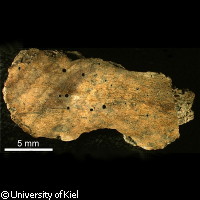Ancient worm found in whale bone
A German-led team of scientists have found traces of a 30-million-year-old worm that ate whale remnants. The bone-eating worm known as Osedax was first described by scientists only six years ago. The new discovery means palaeontologists are now able to identify the worm's remarkable geological age. Results from the study are published in the Proceedings of the National Academy of Sciences. A team headed by palaeontologist Dr Steffen Kiel from the Institute of Geosciences at Christian-Albrechts-University at Kiel in Germany made the discovery on 30-million-year-old whale rib fossils. The bone fragments show circular boreholes approximately 0.5 millimetres in diameter. It was determined that when the dead whale sank to the deep-sea floor millions of years ago, its remains served as food for Osedax; a practice that continues to this day. Living specimens of Osedax were first found in 2002 by biologist Robert Vrijenhoek, who had been searching for deep-sea clams in Monterey Canyon, California, US. He stumbled across the decaying whale carcass at about 3 000 metres deep into the sea, and noticed a proliferation of red worms covering the body. After consulting Dr Greg Rouse, researcher from the South Australian Museum in Australia, and Dr Shana Goffredi, then member of Dr Vrijenhoek's team, it was determined that two new species of worms had been discovered. Their 2004 published paper names the worms as Osedax rubiplumus and Osedax frankpressi. The two worms perform slightly different roles; the former colonises the whale carcass early in the process, while the other colonises later and lives a longer life. Since the initial finding, several more Osedax species have been discovered, including new species living near Japan and Sweden. For the Kiel finding, Dr Rouse (as one of the original Osedax discoverers) was also called on to provide evidence of the boreholes and cavities made by the living worms. But before anything could be determined, the ancient bones were CT (computerised tomography)-scanned to provide precise images of the fossil boreholes. The age of the whale fossil was established using so-called co-occurring index fossils. The same method determined the species of the whale that was established to be an ancestor of modern-day baleen whales. 'The age of our fossils coincides with the time when whales began to inhabit the open ocean,' Dr Kiel explained. Although Dr Kiel and his team note that older fossils should certainly be studied, the discovery does suggest an evolutionary link between Osedax and its main food source. 'Food is extremely rare on the vast deep-sea floor and the concurrent appearance of these whales and Osedax shows that even hard whale bones were quickly utilised as food source,' he added. Identifying the age of Osedax does not necessarily signal good news for vertebrate palaeontologists, since it means the worm has been feeding on precious evidence for millions of years. In their paper, the scientists note: 'Osedax has been destroying bones for most of the evolutionary history of whales and the possible significance of this 'Osedax effect' in relation to the quality and quantity of their fossils is only now recognised.' The whale bones were found by Dr Jim Goedert from early Oligocene bathyal sediments exposed in Washington State, US. A close colleague of Dr Kiel's, Dr Goedert has been collecting fossils for more than 30 years along the US Pacific coast, a geologically rich region where fossil sediments are constantly uplifted by plate tectonic processes.
Countries
Germany



